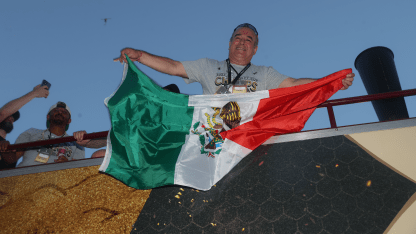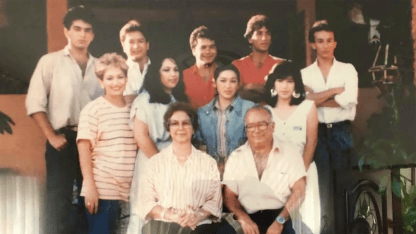-----
Lopez was making pizza sauce when the first call came in.
The voice on the other end was cursing, telling Lopez that they knew his restaurants were doing well, that it was time to pay up.
“If you want to keep your businesses safe, you’re going to have to give us 5,000 pesos per month for each store,” the voice said on the call, back in 2010.
"I’m not going to do that," Lopez said.
That Sunday, a man, nearly dead, was thrown onto his doorstep.
“They yelled at me, ‘This is how you’re going to end up [expletive],’” Lopez said. “I was trying to help the guy to [get himself together], but he said, ‘No, no, no, no, no, no, leave me alone. You didn’t see anything.’”
The phone calls continued, becoming more specific, more threatening, more personal. They would describe his daughter Celina’s outfit as she worked out at the gym, vulnerable and unaware. Jesus would grab a delivery motorcycle from the restaurant and ride there, in a panic, not knowing what he would find.
It is a problem that plagues Mexico, that results in travel advisories and causes terror in the lives of Mexican citizen: the cartels. They use threats and kidnapping, violence and extortion, as criminal organizations often based on drug trafficking. La Familia Michoacana, which came along in 2006, became a force by the early 2010s, when the Lopez family was first targeted.
“They were a group of traffickers that had worked with the Gulf Cartel against other traffickers, but at some point they split with the Gulf Cartel and their armed wing, the Zetas,” said Nathan Jones, an associate professor of security studies at the College of Criminal Justice at Sam Houston State University, who studies organized crime violence and drug trafficking organizations in Mexico. “And they announced themselves kind of brutally and violently, throwing severed heads onto a dance floor and announcing they were there to protect the people.
“But La Familia Michoacana, for all their talk of protecting the people, they also victimized the local population through things like extortion.”
Local business owners who made money, especially in a noticeable way, would become targets for the cartel, objects of their desire.
Lopez and his family had been in the pizza business for 45 years, his older brother opening their first restaurant in 1980. By the time those he believed to be from the cartel came for them, they had opened 16 or 17 outposts of Santino’s Pizza -- a nod to James Caan’s character in “The Godfather” -- around the state of Jalisco, their logo traditional and ubiquitous. It was something that would have been enticing to the cartels, the potential for a significant payday.
“They were battling the Zetas in this period, which is known as being a particularly violent and vicious group,” said Jones, the author of “Mexico’s Illicit Drug Networks and the State Reaction.” “Both La Familia and Zetas are known for being violent and vicious and extorting the local population. And they’re really diversifying. They’re not just drug traffickers. They’re not just moving drugs from Point A to Point B. They are getting themselves involved in almost criminal governance. There are places where they’re providing dispute resolution in cities and towns. They’re trying to extort businesses and extortion is becoming only a bigger and more widespread issue.”
Though Lopez’s brother Armando wasn’t in the pizza business -- he had a shop selling sheets of wood in their hometown, known for its furniture production -- Lopez once entered his office, only to find Armando on the floor with a gun pointed at his head.
The feelings were of hopelessness -- and helplessness.
“Extortion is one of the crimes that is notoriously underreported,” Jones said. “People don’t file reports. … They don’t trust that anything good is going to happen from that process. There’s also the feeling in their back of their mind, what if the cops are in on it?”
The family believed that there was no point in going to the police, in seeking out authorities they did not and could not trust. In Jalisco, where the Lopez family lived, up to 20 percent of the municipal police force are in collaboration with cartels and 70 percent would not act against them, the state’s attorney general, Eduardo Almaguer, told Reuters in 2016.
“The cartels have their people just watching over people,” said Lopez, who was living at the time in Ocotlán, a city not far from the border between Jalisco and Michoacan. “Who bought a new car, who was building a big home, and they just called them because they assumed they had the money. When I finished my house, my house was a beautiful big house, so they thought that I had money, probably.”
And they wanted it. Soon the threats became even more specific, with timelines and details. They had known others who had gotten similar phone calls, similar threats, with the callers identifying themselves as members of La Familia Michoacana, and so the Lopez family believed they were being targeted by the same cartel.
At the time, there was only so much Jorge understood. He was just 11 years old. But he saw the impact it had on his mother, on his father.
“The scariest part was just seeing my parents cry and my sister cry,” Jorge said. “All you see is grownups cry.”
From then on, they couldn’t shake the feeling -- that they were being watched, that something sinister was out there, that someone was out to get them.
“You never get that full sense of security [back],” Jorge said. “Once somebody describes what you’re wearing, you’re always kind of looking over your shoulder, seeing if somebody is watching you.”
Jesus Lopez knew it was time to go. He left Mexico on Oct. 28, 2011.
But for his family, still in Ocotlán, it only got worse.
“It was almost like they knew my dad was already gone,” Jorge said.
There was a day, around the end of February or beginning of March of 2012, that started with demands for ransom money, with threats. The words became more violent, more frightening, talk about coming to sack their house, to kill their mother, to shoot everyone inside. The voices told the 18-year-old Celina the call was a kind of grace, as they described their mother Carmen’s clothing, as they left no question how close they were.
“There was nothing we could do about it,” Jorge said. “We just had to say goodbye to our mom. They were just going to come in bullets up and not ask any questions.”
They gave her terrifyingly specific instructions, to get dressed, to take Jorge and put him in the red truck outside, a 1995 candy-apple red Chevrolet Silverado, and go to a particular grocery store.
“She’s crying and she’s bawling and she throws shoes at me,” Jorge said. “She’s like, ‘Get dressed. They’re coming into the house.’ … She was screaming at the top of her lungs in the garage. It was almost as if a dog was crying, which is a really weird sound.”
She hurled a pair of Pirma soccer shoes at Jorge and, trusting her implicitly, he put them on. She snatched the truck’s keys from Carmen, back in the kitchen of the family’s pizzeria, built on the same property as their home.
Carmen, taken aback, managed to talk her down, out of the panic attack, as Celina yelled over and over again that people were coming in to kill them. Carmen ripped the keys back her from daughter’s hand, the phone away from her, ended the call.
There was no coming back from that.






















